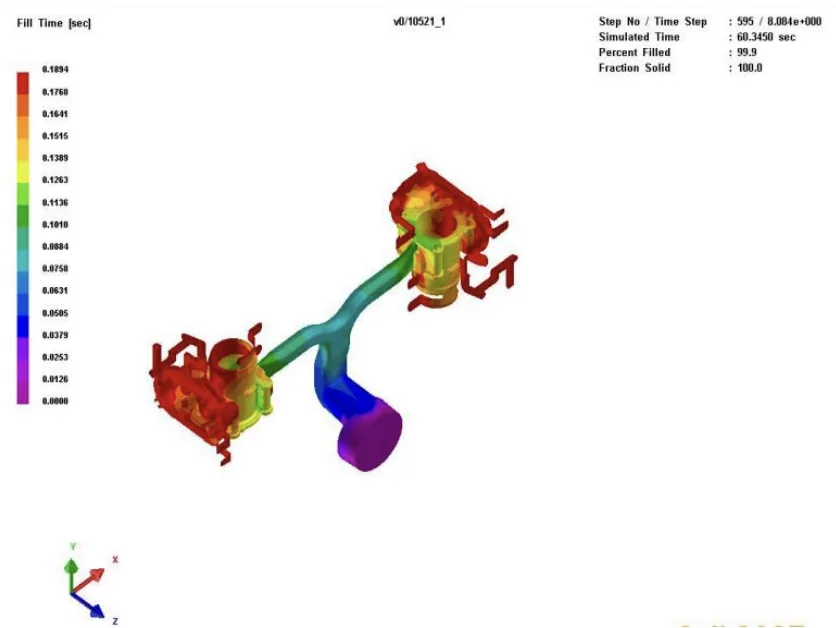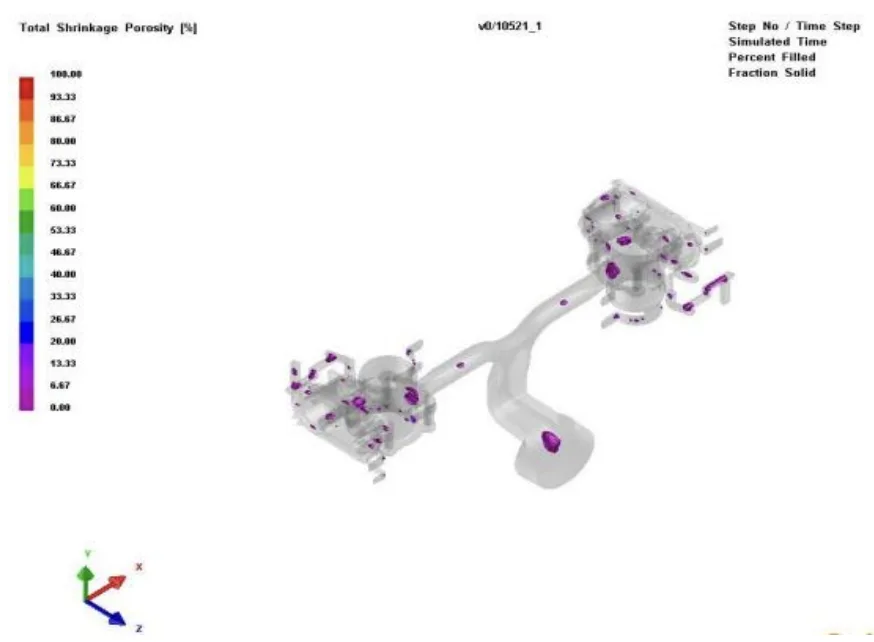This introductory paper is the research content of the paper "IMPROVING QUALITY AND EFFICIENCY IN DIE CASTING OF COMPLEX HOUSINGS" published by Anveshana's International Journal of Research in Engineering and Applied Sciences.

1. Overview:
- Title: IMPROVING QUALITY AND EFFICIENCY IN DIE CASTING OF COMPLEX HOUSINGS
- Author: Naveen Singhal, Dr. Sangeeth Gupta, Dr. Krishnamachary P C
- Publication Year: 2023
- Published Journal/Society: Anveshana's International Journal of Research in Engineering and Applied Sciences (VOLUME 8, ISSUE 7 (2023, JULY))
- Keywords: Light weighting, Aluminum casting alloys, Fuel consumption.
2. Abstract
In order to provide ecological balance, new technologies are being developed to reduce fuel consumption. Within these new technologies, usage of light alloys such as aluminum and magnesium has gained great importance in the automotive applications. The advantages of aluminum alloys in terms of light weight, recycling, machinability and corrosion resistance led to increase application area of these alloys. Aluminum applications increase not only in automotive, but also in aerospace, space shuttle, marine, and defense applications. According to the production methods, aluminum alloys are generally classified as casting, sheet, forging and extrusion. Aluminum die casting alloys are generally used the production of suspension systems, engines and gears parts. In this study, the importance of the use of aluminum die casting alloys in the automotive industry is emphasized. Research and trends so far of the development of aluminum die casting alloys are also summarized.
3. Research Background:
Background of the research topic:
- Weight reduction in vehicles is crucial for improving fuel economy and reducing emissions.
- Lightweight materials, especially aluminum alloys, are increasingly important in automotive applications.
- Aluminum alloys offer advantages in weight, recyclability, machinability, and corrosion resistance.
Status of previous research:
- Aluminum alloys have been used in aviation and defense for a long time.
- Casting aluminum alloys are widely used in automotive industry.
- Up to 20-30% of all aluminum products manufactured worldwide are used for aluminum die castings.
- Prior research has investigated:
- The impact of casting defects on mechanical properties (Drezet, JM, Rappaz et al (2000)).
- The effects of alloy composition on porosity and fatigue limit (H. Mayer, (2003)).
- Optimization of casting process parameters using Taguchi methods (Kumar Sudhir et al. (2006)).
- Automated quality evaluation techniques using image recognition (Dobrzanski et al. (2007)).
- Selection criteria for die-cast part separation paths (Madan et al. (2009)).
Need for research:
- The increasing use of aluminum die casting, especially in electric vehicles, necessitates further research into quality and efficiency improvements.
- The complex shapes of modern automotive components present challenges for die casting.
4. Research purpose and research question:
Research purpose:
- To emphasize the importance of aluminum die casting alloys in the automotive industry.
- To summarize research and trends in the development of aluminum die casting alloys.
Core research:
- The core research is to use simulation to find optimal casting parameters.
5. Research methodology
- Sample: 200 tonnes of HPDC-molded AZ91D alloys.
- Casting Parameters: Molten metal temperature (578°C), solid magnesium temperature (430°C), die temperature (200°C), pouring temperature (630°C), plunger speeds (0.14 - 0.83 m/s).
- Equipment: Vacuum pump, vacuum tank, Universal Electromechanical Instron 5569.
- Analysis Software: Quik Cast program.
- Microstructural Examination: Optical Microscope (OM), Scanning Electron Microscope (SEM).
- Methodology detail:
- The original technique of casting was to transfer molten fluid to injection chamber.
- Secondly, plunger filled the cavity and passed through sprinkler gap.
- There was activation vacuum mechanism pressure in the die cavity was less than in surrounding atmosphere.
- Without heat treatment, traction samples were evaluated.
6. Key research results:
Key research results and presented data analysis:
- Fill Time Analysis:
- Figure 6.4 shows the fill time for the first experiment. The red-colored areas indicate sensitive spots with an average filling time of 0.1894 seconds.
- Figure 6.5 provides an enlarged view of the first experiment's simulation, highlighting partially filled regions.
- Graph 6.1 represents the maximum filling time for each simulation, showing that iteration 2 had the longest filling time.
- Shrinkage Porosity Analysis:
- Figure 6.8 shows the total shrinkage porosity for the first experiment. Porosity concentration was around 20-30%.
- Mechanical Properties:
- Table 6.11 presents the mechanical properties of the cast parts, showing the relationship between tensile strength, elongation, and porosity.

List of figure names:
- Figure: 6.4 Fill time for the 1st experiment
- Figure: 6.5 Analysis image of the 1st experiment
- Graph: 6.1 representation of maximum filling time for each simulation
- Figure: 6.8 Total shrinkage porosity for the 1st experiment
7. Conclusion:
Summary of key findings:
- Thermographic analysis can be used to study die action and temperature distribution.
- The continuous casting method can be analyzed using a complex CFD analysis.
- The mathematical model is useful for predicting flux behavior and temperature profiles.
- Tensile properties of HPDC magnesium parts depend on grain size and porosity.
- The porosity effect is more significant than the kernel size effect.
8. References:
- 1. Fiorese, E.; Richiedei, D.; Bonollo, F. Improved metamodels for the optimization of high-pressure die casting process. Metall. Ital. 2016, 108, 21–24.
- 2. G.F.Mi, C.Y.Li and K.F.Wang. Numerical Simulation and Application of Low Pressure Die-casting Aluminum Alloy Wheel. Hot Working Technology 2013, Vol.42, No.7, pp: 60-62.
- 3. Gerrit Dumstorffa, Christoph Pille b, Rico Tiedemanna, Matthias Busseb, Walter Langa, Smart aluminum components: Printed sensors for integration into aluminum during high-pressure casting, The Society of Manufacturing Engineers. Published by Elsevier Ltd.,166–172, ( 2017).
- 4. Guharaja S., Noorul Haq A., Karuppannan K.,M., 2006, “Optimization of green sand casting process parameters by using Taguchi's method”. International Journal of Advanced Manufacturing Technology, Vol.30, pp.1040–1048.
- 5. Gunasegaram, D.R.; Givord, M.; O'Donnell, R.G.; Finnin, B.R. Improvements engineered in UTS and elongation of aluminum alloy high pressure die castings through the alteration of runner geometry and plunger velocity. Mat. Sci. Eng. A 2013, 559, 276–286
- 6. H. B. R. Bhatt, "A design optimization of feeding sys- tem and solidification simulation for cast iron," in Proceeding on 2nd International Conference on Innovations in Automation and Mechatronics Engineering, 2014.
- 7. H. Mayer, M. Papakyriacou, B. Zettl, S.E. Stanzl-Tschegg," Influence of porosity on the fatigue limit of die cast magnesium and aluminium alloys", International Journal of Fatigue 25 (2003)245–256, 2003
- 8. Hsu, Q.C.; Do, A.T. Minimum porosity formation in pressure die casting by Taguchi method. Math. Prob. Eng. 2013, 2013, 1-9.
- 9. J. Madan, P. V. M. Rao, and T. K. Kundra, "Optimal-parting direction selection for die-casting," Int. J. Manuf. Technol. Manag., vol. 18, no. 2, pp. 167–182, 2009.
- 10. Jer-Haur Kuo, Feng-Lin Hsu, Weng-Sing Hwang, Development of an interactive simulation system for the determination of the pressure-time relationship during the filling of a low-pressure casting process, Science and technology of advanced materials 2 (2001) 131- 145
9. Copyright:
- This material is a paper by "Naveen Singhal, Dr. Sangeeth Gupta, Dr.Krishnamachary P C": Based on "IMPROVING QUALITY AND EFFICIENCY IN DIE CASTING OF COMPLEX HOUSINGS".
- Source of paper: [Paper not provided, thus no DOI]
This material was created to introduce the above paper, and unauthorized use for commercial purposes is prohibited. Copyright © 2025 CASTMAN. All rights reserved.